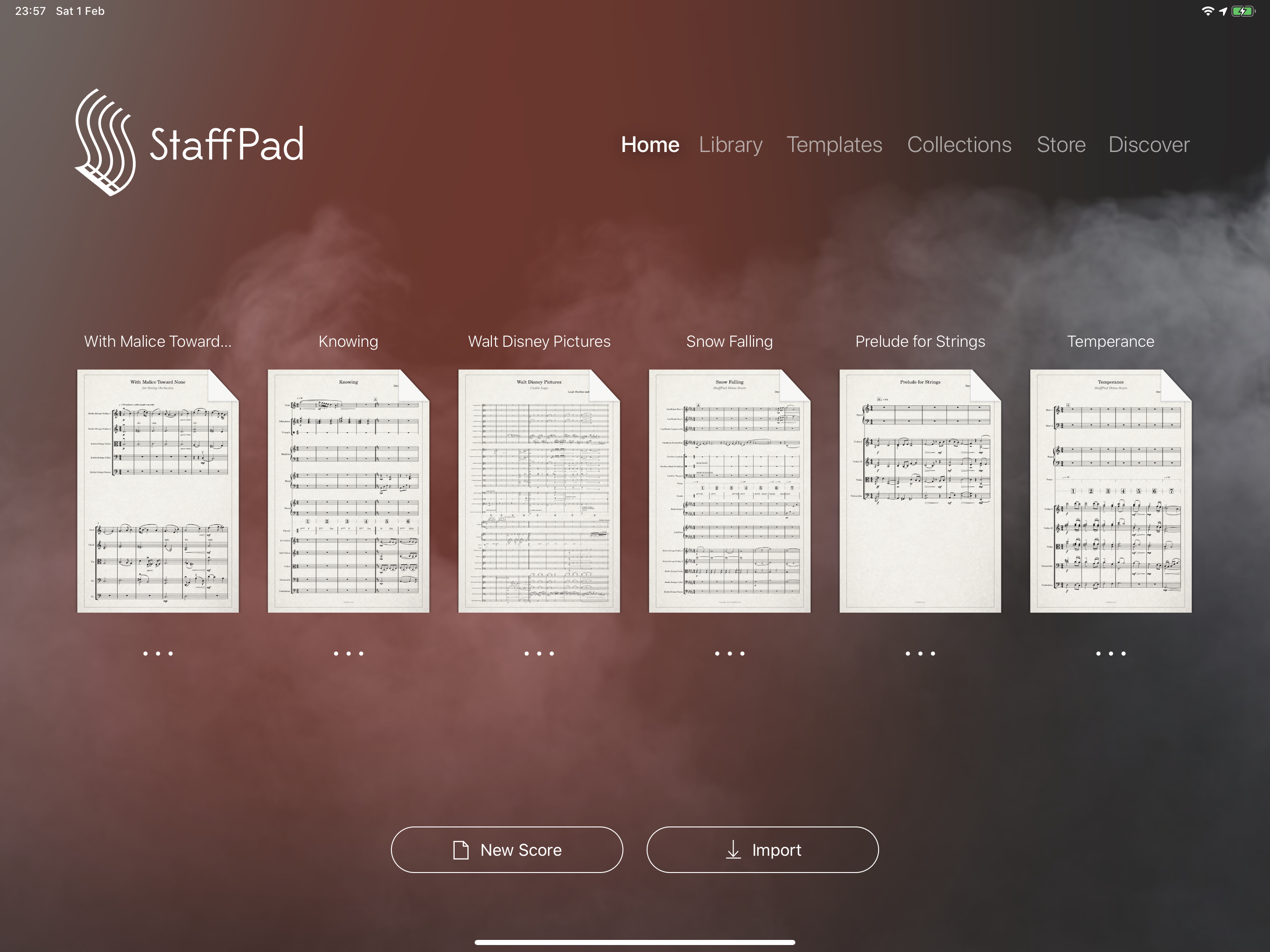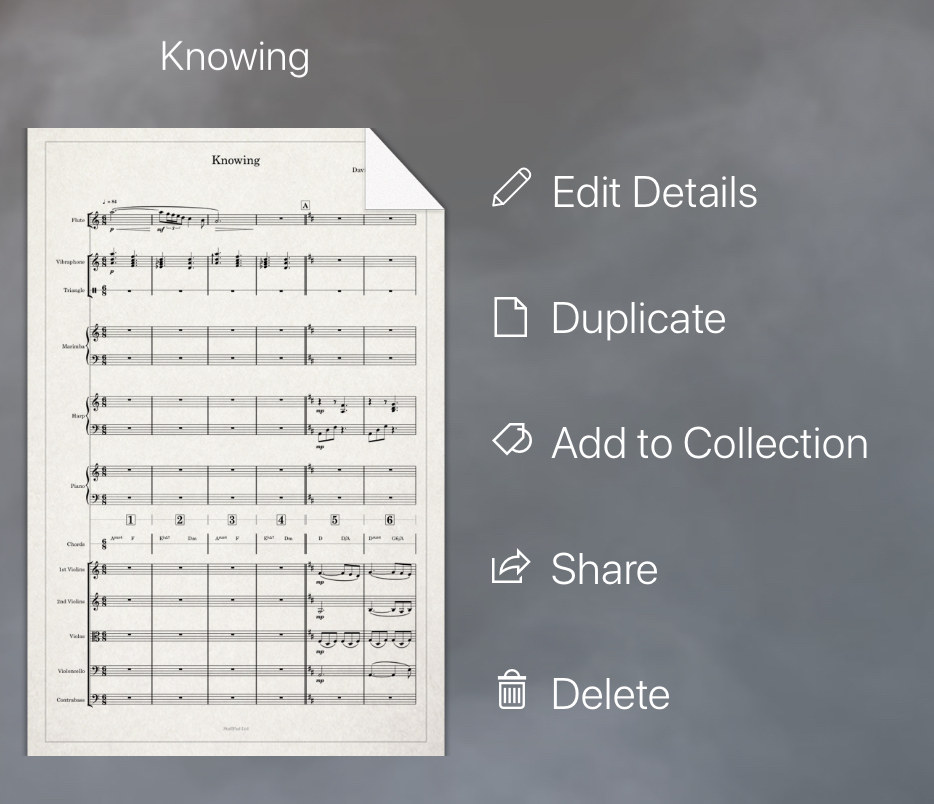When you start StaffPad, or when you tap the Home ![]() icon on the Command bar you’ll be greeted by StaffPad’s Welcome Page.
icon on the Command bar you’ll be greeted by StaffPad’s Welcome Page.

The Welcome Page has a dynamic, changing background that updates itself based on the time of day, and the weather outside. For example, you'll see dark moody backgrounds if it's late at night, bright blues and yellows if it's a sunny morning, and muted greys and greens if it's an overcast afternoon.
From here you can manage your scores and templates, organise them into collections, add more instrument sounds via the store, and get help on using StaffPad.
The Top Menu
At the top of the screen you’ll see several items: Home; Library; Templates; Collections; Store; Discover. Tap or touch any item to select it. You can also swipe left or right to move through each of these items.
On the Home page, you’ll see your six most recent scores, represented by a preview page of the score itself. Tap on a score to open it.
The Library is a complete list of your scores. This is sorted alphabetically by default, but you can switch to sort by composer by tapping the "Sort by Composer" text at the top of the list. Swipe up or down to navigate through the list of scores. Tap a score title to open it.
Templates are scores with pre-assigned instruments to help you quickly start writing. You can always add or delete instruments to a score after creating one (see Creating a score and adding instruments) and you can create your own templates (see Saving a score as a template).
Collections are groups of scores. They are not hierarchical in the way that folders are. Instead, you can add a score to as many collections as you like; in a way, they function like tags.
Search
You can search the Library, Collections and Templates screens by scrolling up past the top of the list to reveal a search bar.
From the Store you can purchase additional instruments to add to StaffPad. Each instrument comes complete with a detailed description and professionally recorded sound samples.
Discover brings up a series of video tutorials, interactive lessons, and this help guide.
New Score
To begin writing, just tap the "New Score" button on the Home page. This will bring up the score page where you can add instruments and start writing your score.
Importing an existing score
StaffPad can import MusicXML files, MIDI files and of course, other StaffPad files. StaffPad does not import scans or PDF files.
MusicXML files have the extension .xml, .mxl or .musicxml and are usually generated by other music notation programs.
MIDI files have the extension .mid or .midi, and are often generated by sequencers or DAWs.
Wherever possible, use MusicXML as a score interchange format. MIDI files contain no real notation semantics - they are just a collection of note on and off events, rather than contain information about staff types, slurs, dynamic markings, articulations and so on. Most DAWs and sequencers can export MusicXML files, and you should choose this whenever possible for the best results.
MIDI Files
If you must use MIDI files, make sure you quantise them carefully -- including quantising the note lengths and note ends. Also, make sure your MIDI tracks are named as per the instrument you want them assigned in the score; e.g. "Violins 1" or "Piano".
More you can do with your score
Anywhere a score appears, you’ll see a More ![]() icon (three dots near the score’s name).
icon (three dots near the score’s name).

Select More ![]() to do the following:
to do the following:
 Edit Details
Edit Details- This lets you edit the title, subtitle, composer, arranger and lyricist, as well as add some additional information that appears on the printed score only, like Copyright information (which will appear at the bottom of page 1 on the printed score).
 Duplicate
Duplicate- This gives you a quick and easy way of simply duplicating the score file. Perfect for when you need to copy the score for a backup or to start a fresh take on it.
 Add to Collection
Add to Collection- This will give you the option to add the score to a Collection of scores (more in The top menu). Simply select each Collection to which you wish to add the score, and StaffPad will place a checkmark next to it. A score can be in as many collections as you wish. Select Create New Collection to start a new collection, and then name it. You can also rename Collections at any point by simply tapping their name in the list, on the Collections screen.
 Share
Share- From this Share control, you can quickly print the score or create a PDF, export audio as MP3, WAV or AAC (or Flac, on Windows), export the score as MusicXML or MIDI, save the score as a template of staffs for re-use later, or simply share the StaffPad score file (.stf file format) itself with other users. More exporting options are in (Exporting your score).
 Delete
Delete- This will delete your score. A warning appears asking “Are you sure?” Select
 to cancel the deletion, or
to cancel the deletion, or  to accept.
to accept.